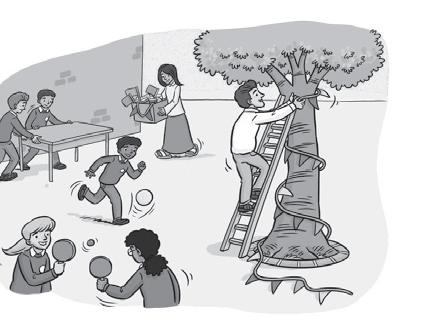
11 minute read
How to use this Teacher’s Resource
This Teacher’s Resource contains both general guidance and teaching notes that help you to deliver the content in our Cambridge Global English resources. Some of the material is provided as downloadable files, available on Cambridge GO. (For more information about how to access and use your digital resource, please see inside front cover.) See the Contents page for details of all the material available to you, both in this book and through Cambridge GO.
Teaching notes
This book provides teaching notes for each unit of the Learner’s Book and Workbook. Each set of teaching notes contains the following features to help you deliver the unit.
The Unit plan summarises the lessons covered in the unit, including the number of learning hours recommended for the lesson, an outline of the learning content and the Cambridge resources that can be used to deliver the lesson.
Lesson Approximate number of learning hours Outline of learning content Learning objective Resources
1 Celebrating together 1.5–2.5 Ask and answer questions. 3Ld.01 3Ld.02 3Sc.03 3Sc.06 3Rd.01 3Ug.01 Learner’s Book Lesson 1.1 Workbook Lesson 1.1 Photocopiable 4 Digital Classroom: Video and activity sheet – Celebrating the New Year in China; Activity – Activity sounds
The Background knowledge feature provides information which helps the teacher to familiarise themselves with the cross-curricular and international content in the unit. Learners’ prior knowledge can be informally assessed through the Getting started feature in the Learner’s Book. BACKGROUND KNOWLEDGE
It is useful to have a good understanding of a range different literary genres (historical fiction, traditional folk and fairy tales and myths, science fiction, mystery stories, fantasy fiction, adventure stories, etc.).
The Teaching skills focus feature covers a teaching skill and suggests how to implement it in the unit. TEACHING SKILLS FOCUS
The challenge with active learning is to stop yourself telling learners things that they could discover for themselves.
Reflecting the Learner’s Book, each unit consists of multiple lessons. At the start of each lesson, the Learning plan table includes the learning objectives, learning intentions and success criteria that are covered in the lesson. It can be helpful to share learning intentions and success criteria with your learners at the start of a lesson so that they can begin to take responsibility for their own learning.
There are often common misconceptions associated with particular grammar points. These are listed, along with suggestions for identifying evidence of the misconceptions in your class and suggestions for how to overcome them. At Cambridge University Press, we have unique access to the Cambridge Learner Corpus to help us identify common errors for key language groups.
For each lesson, there is a selection of starter ideas, main teaching ideas and plenary ideas. You can pick out individual ideas and mix and match them depending on the needs of your class. The activities include suggestions for how they can be differentiated or used for assessment. Homework ideas are also provided, with home-school link suggestions to enable learners to continue their learning at home.
LEARNING PLAN
Learning objectives Learning intentions
3Ld.01, 3Ld.02 • Listening: Listen to a description of a festival; listen for specific information; listen for information and instructions. • Learners can sing a song.
Success criteria
Misconception Learners add an unnecessary subject pronoun where an imperative form is needed. For example: You don’t forget book. Please you come to my birthday party. How to identify Write a correct sentence and an incorrect one. Ask learners to compare the sentences. Ask: What’s the difference between the sentences? Which is correct? Circle the unnecessary pronoun. Say: Do we need this? Why not? Who am I giving this order to? Elicit answers. How to overcome Learners read the sentence and ask themselves these questions: Are they giving an order? If they are, who are they talking to? Is it necessary to add the pronoun?
Starter ideas
Team players (15–20 minutes)
• In order to focus learners’ attention back on the topic of team activities, ask the class what team activities they like to do at school and in their
English class, for example play games, look for information, do an exercise together. • Elicit the meaning of ‘team’. Ask: How many children are in a team – one, two, more? And in a basketball team? What sports do we play in teams?
How many players are there in each team? • This lesson incorporates a review of numbers (1–100) for the first time in Stage 3. You could play a few rounds of Bingo to cover these numbers again. Prepare one blank bingo grid for each learner, and numbers 1–100 on pieces of paper. Put the numbers in a bag or small box. Ask learners to write numbers 1–100 in their grid. Randomly call out the numbers and learners cross out the numbers on their Bingo grids. The winner is the first learner to get a line or full house.
The Language background feature contains information to help you present the grammar in the unit. LANGUAGE BACKGROUND
Present continuous Remind the class of the use and the form of the present continuous.
The Cross-curricular links feature provides suggestions for linking to other subject areas. CROSS-CURRICULAR LINKS
Geography Display the map of the world and ask the class to find China on the map. What do learners know about this country?
Differentiation ideas: This feature provides suggestions for how activities can be differentiated to suit the needs of your class.
Critical thinking opportunity: This feature provides suggestions for embedding critical thinking and other 21st-century skills into your teaching and learning.
Assessment ideas: This feature highlights opportunities for formative assessment during your teaching.
Digital Classroom: If you have access to Digital Classroom, these links will suggest when to use the various multimedia enhancements and interactive activities.
Answers: Answers to Learner's Book exercises can be found integrated within the lesson plans and Learner's Book and Workbook answer keys are also available to download.
Note: Some texts used in the Learner’s Book and Workbook have been abridged, so please be aware that learners may not be presented with the full version of the text.
Digital resources to download
This Teacher’s Resource includes a range of digital materials that you can download from Cambridge GO. (For more information about how to access and use your digital resource, please see inside front cover.) This icon indicates material that is available from Cambridge GO. Helpful documents for planning include: • Letter for parents: a template letter for parents, introducing the Cambridge Global English resources. • Lesson plan template: a Word document that you can use for planning your lessons. Examples of completed lesson plans are also provided. • Curriculum framework correlation: a table showing how the Cambridge Global English resources map to the Cambridge Primary English as a Second Language curriculum framework. • Scheme of work: a suggested scheme of work that you can use to plan teaching throughout the year. Each unit includes: • Differentiated worksheets: these worksheets cater for different abilities. Worksheet A is designed to support learners who don’t feel confident about the topic. Worksheet B is designed for learners who have a general understanding of the topic. Worksheet C is aimed at learners who want a challenge. Answer sheets are provided. • Photocopiable resources: these include communicative language game, templates and any other materials that support the learning objectives of the unit. • Sample answers: these contain teacher comments, which allow learners and teachers to assess what ‘good’ looks like in order to inform their writing. • Self-evaluation checklists: checklists for learners to use to evaluate their writing and project work. Additionally, the Teacher’s Resource includes: • Progress test 1: a test to use at the beginning of the year to discover the level that learners are working at. The results of this test can inform your planning. • Progress test 2: a test to use after learners have studied Units 1-5 in the Learner’s Book. You can use this test to check whether there are areas that you need to go over again. • Progress test 3: a test to use after learners have studied all units in the Learner’s Book. You can use this test to check whether there are areas that you need to go over again, and to help inform your planning for the next year. • Progress report: a document to help you formatively assess your classes’ progress against the learning objectives. • Audioscripts: available as downloadable files. • Answers to Learner’s Book questions
• Answers to Workbook questions
• Wordlists: an editable list of key vocabulary for each unit. In addition, you can find more detailed information about teaching approaches. Audio is available for download from Cambridge GO (as part of this Teacher’s Resource and as part of the digital resources for the Learner’s Book and Workbook). Video is available through the Digital Classroom.
CAMBRIDGE GLOBAL ENGLISH 3: END OF UNIT 1 TEST
Name___________________________________ Date_____________ End of Unit 1 test
Vocabulary 1
Look at the picture. Choose the correct word for each sentence. Write the word in the space.
CAMBRIDGE GLOBAL ENGLISH 3: PHOTOCOPIABLE ACTIVITIES standing climbing kicking bouncing measuring carrying
Photocopiable 1: Writer’s checklist Aim: To encourage correct use of punctuation and learner autonomy. Learners use the checklist after completing written work that contains direct speech. They can use it to check their own work or their partner’s work. Preparationtime: 5 minutes Completiontime: 10 minutes Languagefocus: Correct punctuation – capital letters, full stops, commas, question marks and exclamation marks Materials: One copy of Photocopiable 1 for each learner s checklist Example: 0 A boy is bouncing tters, full stops, commas, CAMBRIDGE GLOBAL ENGLISH 3: END OF UNIT 1 TEST a red ball. When learners have completed a writing task in class, give each a copy of Ask learners to read their written work and use the checklist to check their work for correct punctuation. Then they make any corrections necessary. CAMBRIDGE GLOBAL ENGLISH 3: PROGRESS TEST 1 Name___________________________________ Date_____________ Progress Test 1Vocabulary 1 Draw a circle around the correct word. CAMBRIDGE GLOBAL ENG ___________________________Vocabulary 1
Procedure: When learners have completed a writing task in class, give each a copy of Photocopiable 1. Ask learners to read their written work and use the checklist to check their work for correct punctuation. Then they make any corrections necessary. 1 A boy is _________________ a tree. 2 Two girls are _________________ a table. Grammar 1 Write is, Is, are or Are in the spaces. Example: 0 Where is 3 A boy is _________________ a box. Harry sitting?



[1]
[1]
4 A small child is _________________ on a chair.
11 5 A girl is _________________ a blue ball. What ____________ Dani and Yolanda doing? What ____________ Dani and Yolanda doing?
12 ____________ writing a poem easy? ____________ writing a poem easy?


Example: [1] Cambridge Global English 3 – Elly Schottman and Paul Drury© Cambridge University Press 2021 Global English–Helen Tiliouine© Cambridge University Press 2021 0 Two girls are skipping/ hittinga small red ball.1 The man is jumping/ standingon a ladder. 1 2 The woman is carrying/ measuringa box. 3 Two boys are stepping/ kickingblue balls. 4 A boy is stepping/ bouncinga yellow ball. 5 A girl is holding/ skippinga rope. Global English – Helen Tiliouine© Cambridge University Press 2021 [1] [1] Global English – Helen Tiliouine© Cambridge University Press 2021 3 [1] [1] 13 Where ____________ they playing football today? [1] 14 We ____________ eating ice cream. [1] 15 ____________ she reading about animals? [1] a small red ball. [1] [1] [1] ____________ they playing football today? We ____________ eating ice cream. ____________ she reading about animals? CAMBRIDGE GLOBAL ENGLISH 3: PHOTOCOPIABLE ACTIVITIES Name ___________________________________ Date _____________ Photocopiable 1: Writer’s checklist 1 The first word of a sentence begins with a capital letter.This is a book. The word Iis always written with a capital I.I am a student. The name of a person, city, country or school begins with a capital letter.Tanya Mr Kim Athens Korea International School The days of the week and the names of the months begin with a capital letter. Monday Tuesday January February Most sentences end with a full stop My name is Tony. A question ends with a question mark.What’s your name? A sentence that shows surprise or excitement ends with an exclamation mark. My name is Tony too! When you write a list of things, put a comma (,) after each word. You don’t need a comma before the word ‘and’ . I saw an elephant, a camel, a zebra and a kangaroo. [1]
[1]
[1]
[1]
[1]
1



Cambridge Global English 3 – Elly Schottman and Paul Drury© Cambridge University Press 2021

2


